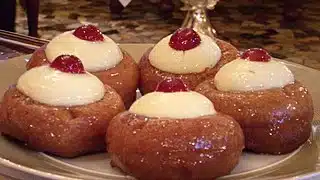In 2010, UNESCO recognized the significance of French cuisine, including its pastries, by designating it as part of the world heritage.
This post aims to uncover the origins of these renowned treats, known for their exquisite taste and appealing appearance. Preparing French pastries demands technical skill, creativity, and precision, making them culinary masterpieces.
The most iconic French pastries include: • Viennoiserie - yeast-leavened pastries: brioche, croissant, pain aux raisins, pain au chocolat • Pastries made from puff pastry: millefeuille, palmier, pithivier • Pastries made from pâte à choux: éclairs, profiteroles, croquembouche, Paris-Brest • Cakes, tarts and small treats: charlotte, savarin, tarte Tatin, madeleines, cannelés, macarons, baba au rhum, financiers, tuile, gâteau opéra, gâteau Saint-Honoré
A Brief History of French Pastry Making
The roots of French pastry-making can be traced back to the Middle Ages. During the 1400s, pâtissiers took over the production of pastries from bakers, marking the beginning of the evolution of French pastry-making and the emergence of new products.
In the 1500s, the introduction of cane sugar, cocoa, and chocolate from the Americas led to further sophistication in pastry production. Following the French Revolution, previously exclusive pastry products reserved for the nobility became accessible to the general public as well.
A pivotal figure in the realm of French pastry-making was chef Marie-Antoine Carême (1784-1833). His exceptional desserts and pastries elevated the profession to an artistic level. His book “Le pâtissier royal” stands as the first systematic account of pastry cookery.
Interestingly, the English term “pastry” is synonymous with the French word “pâtisserie,” which denotes a bakery specializing in pastry products. The skilled professional behind these creations is known as a “pâtissier.”
French cuisine embraces dishes inspired by other nations, adding diversity to its array of pastries and desserts. In the following chapters, we’ll explore the captivating stories behind the creation of these French pastries and desserts. Each pastry carries a unique story, reflecting the craftsmanship of French bakers throughout history.
Brioche
Originating in the Normandy region of France during the 15th century, brioche is a type of French bread. It underwent further refinement and gained popularity in Paris during the 17th and 18th centuries. The name “brioche” is believed to have evolved from the Old French term “brier,” signifying “to knead” or “to pound,” reflecting the distinctive texture and preparation technique of the dough. Brioche holds a significant place in French culture.
Its distinctively rich and cake-like texture comes from the inclusion of milk, eggs, butter, and sugar in the dough. Brioche also serves as the foundation for the Tarte Tropézienne, a delectable cake filled with lemon pastry cream
.Some popular brioche variations include Brioche à Tête, known for its distinctive “head” shape; Brioche Nanterre, baked in a rectangular mold with multiple dough balls placed side by side, and named after the town of Nanterre near Paris; and Brioche Vendéenne, originating from the Vendée region, often braided for an attractive appearance.

Madeleine
Madeleines are petite, soft cakes with a distinctive shell shape. Their original recipe was a well-kept secret, available only at a high price. Key ingredients include butter, flour, eggs, and sugar.
The invention of madeleines is shrouded in mystery, with different theories presented. One suggests they were created by Avice, a renowned pastry chef from the 19th century. However, experts argue that madeleines were known in Commercy long before that, possibly in the 1730s. Another belief traces their origin back to the Middle Ages when they were baked inside real seashells.

Financiers
There are two possible stories about the origin of Financiers: one claims that they were first baked by the Visitation nuns in the 1600s, hence also known as “visitandines.” The other origin story suggests they emerged in the financial district of Paris in the 19th century.
One of the defining characteristics of a classic Financier is the use of almond and brown butter. These delectable treats were possibly named after the small, square baking tins used to make them.

Cannelés
The origin of Cannelés can be traced back to the Bordeaux region in southwestern France, specifically to the city of Bordeaux. The pastry’s history is believed to date back to the 18th century. It is said that Cannelés were created by nuns in the Convent of the Annonciades.
One of the defining features of Cannelés is their signature fluted shape, which is achieved by baking the batter in special copper molds. These small, caramelized cakes have a soft and custardy interior, contrasted by a dark and crunchy exterior.
The traditional Cannelés recipe remains relatively unchanged over the centuries. It typically includes ingredients such as milk, flour, egg yolks, sugar, rum or vanilla extract, and butter for greasing the molds.

Tarte Tatin
Tarte Tatin is a distinctive upside-down fruit tart, primarily featuring caramelized apples enveloped in butter and sugar and topped with pastry. Its name pays tribute to the Tatin sisters, who served this dessert to their hotel guests. Legend has it that Stéphanie Tatin accidentally baked the apple cake upside down, resulting in a delicious surprise.
Interestingly, the concept of an upside-down apple tart was not entirely new, as Carême had already mentioned it in one of his books.
Croissants
Contrary to common belief, the croissant’s origins can be traced back to Austria, not France, where it was inspired by the kipferl, a crescent-shaped pastry from Vienna dating back to the 13th century. The kipferl found its way to France in the 1830s when Austrian Princess Marie Antoinette married King Louis XVI. French bakers then refined and adapted the pastry, ultimately producing the modern croissant we enjoy today.
Traditional croissants have a buttery laminated dough, featuring a flaky, crisp outside and a soft, layered inside. Other popular variations include Pain au Chocolat, filled with dark chocolate, and almond croissants with almond cream, sliced almonds, and powdered sugar on top.

Discover the relationship between brioche and croissant dough in our article on the similarities and differences between them.
Profiteroles
The choux pastry, credited to Queen Catherine de Medici’s chef, saw its modern recipe development thanks to Antoine Carême. Profiteroles, small choux pastry balls, are filled with either chantilly cream or vanilla custard and coated with chocolate. These tasty treats are used in Saint-Honoré and croquembouche cakes.

Croquembouche
Croquembouche, a pyramid-shaped confection, is primarily composed of cream-filled profiteroles—choux pastry spheres—held together with caramel. In France, it is a beloved cake frequently served on festive occasions, particularly weddings.
While Marie-Antonin Carême is often credited with its invention, culinary books from the early 1800s already mention the croquembouche, indicating an older origin than Carême’s time.

Gateaux Saint-Honoré
The Saint-Honoré cake, a tribute to the patron saint of pastry chefs and bakers, was created by Parisian confectioners. It features a circular shortcrust or flaky pastry base with the outer edge adorned with profiteroles dipped in caramel. The cake is filled with chilboust cream, a delectable combination of pastry cream, and whipped egg whites.
Paris-Brest Cake
The Paris-Brest cake is a classic French pastry that was created by pastry chef Louis Durand in 1910 to commemorate the 10th anniversary of the Paris-Brest-Paris bicycle race.
Inspired by the shape of a bicycle wheel, the cake is made of a ring of choux pastry filled with a rich praline-flavored cream filling, usually made from a mixture of butter, praline paste, and pastry cream. The cake is often topped with slivered almonds or powdered sugar for added texture and decoration.

Baba au Rhum (Rum Baba)
Rum baba, a small cake made from yeast dough soaked in rum and syrup, is served individually with whipped cream and dried fruit.
According to popular accounts, Baba au Rhum was created in the 18th century by Stanislas Leszczyński, who was the exiled king of Poland and the father-in-law of King Louis XV of France. The story goes that Stanislas, during his time in the French court, was served a dry and tasteless kugelhopf, a traditional European cake. Unimpressed with the cake’s flavor, he asked his pastry chef, Nicolas Stohrer, to improve it.
Stohrer, a talented pastry chef of Polish descent, decided to soak the kugelhopf in a mixture of rum, sugar, and vanilla, transforming it into a deliciously moist and flavorful dessert. Stohrer established his Pâtisserie in 1730 on rue Montorgueil, where it still stands today.

Savarin
avarin is a classic French dessert that belongs to the family of yeast-based cakes known as “baba” or “baba au rhum.” It is named after Brillat-Savarin, a famous French gourmet, and gastronome from the 18th century. The Savarin is a moist and airy cake typically soaked in flavored syrup, often made with rum or other liquor, and is often served with whipped cream and fresh fruits.

Clafoutis
Clafoutis is a classic French dessert made with fresh fruit baked in a custard-like batter. The history of Clafoutis can be traced back to the Limousin region of France, where it is believed to have originated. Originally, Clafoutis was made with black cherries, which are abundant in the Limousin area during the summer months.
Traditionally, it was prepared with unpitted cherries, as the pits were thought to add additional almond-like flavor to the dessert while also preserving the fruit’s shape and texture.

Macarons
Macarons, small desserts made from almond flour, egg whites, and sugar, likely have Italian origins. They were baked in Italian monasteries as early as the 8th century and were later introduced to France during the Renaissance. The Parisian macarons we enjoy today, filled with ganache, buttercream, or jam, were created at the beginning of the 20th century in the Parisian pâtisserie Ladurée.

Charlotte Cake
The exact origin of the Charlotte cake remains unclear, with some attributing it to England and others to France. The English version, recorded in a recipe dating back to 1808, lines the pan with buttered bread and layers of apples, sugar, and milk-soaked bread as the filling.
The Charlotte à la Parisienne (also known as à la russe), invented by Marie-Antoine Carême in 1915, features a mold lined with ladyfingers and filled with Bavarian cream or custard and fruit.
Final thoughts
French cuisine boasts a rich tradition that is celebrated and recognized globally. Among the famous pastries and cakes originating from France are brioche, profiteroles, éclairs, mille-feuille, savarin, financiers, madeleines, and tarte Tatin.
To learn more about the origin of baked goods, you might find my article exploring famous European pastries of interest.


